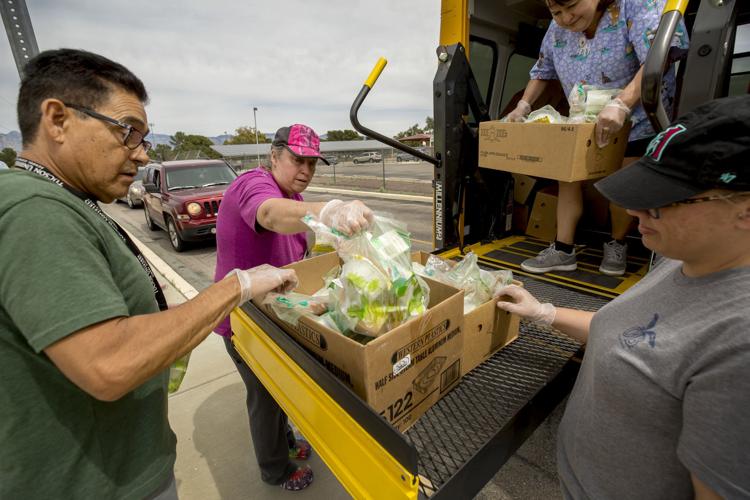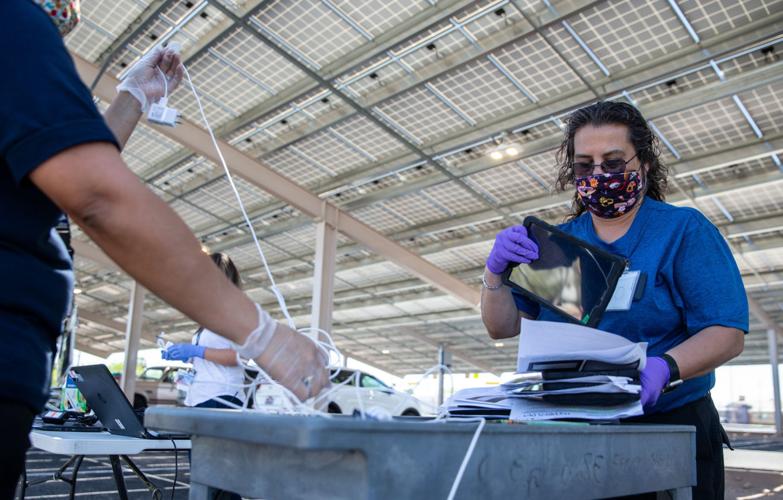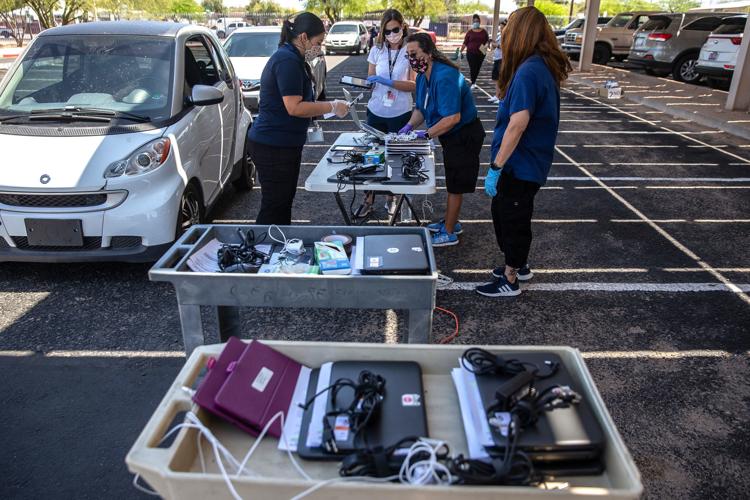Tucson’s largest school district is facing a projected $8.5 million in increased costs due to higher spending and revenue losses brought on by the coronavirus closures.
Thus far, TUSD has spent $3.5 million on Chromebooks for students who did not have a device at home for online learning, over $1 million in curriculum materials and an ongoing $125,000 a month running two child-care centers for children of front-line workers.
“Our costs are staggering,” said Superintendent Gabriel Trujillo.
The district is also facing a possible $3.5 million revenue loss from being heavily in the red on its food bill, Trujillo said.
The district receives federal funding to feed low-income children. However, even though TUSD is only feeding a quarter of the children it usually serves, and it is therefore receiving a quarter of the federal dollars, the district has already purchased enough food to feed its standard number of children and is paying the same number of employees that would have been preparing that food.
The more than $1 million the district spent in curriculum materials includes a $70,000-a-week printing bill during the first month of closures, creating packets for children who couldn’t do their learning online, as well as emergency funding of $131,000, approved earlier this month, to buy workbooks for Grades K-4.
“We’re going to be probably clocking in at about $8.5 million in closure costs at this particular time,” Trujillo said.
To afford the Chromebooks, TUSD put some plans on hold that it had for next year, including school parking lot improvements; adding more librarians in middle schools and music teachers in elementary schools; refurbishing music, band and sports equipment; and more.
To offset the loss on the food bill, the district has to use a portion of funding it targeted for refurbishment of computer labs; classroom digital projectors and interactive whiteboards; and audio and video equipment in schools.
A few costs have come down because of the closures, which can offset some of the unexpected costs.
The district is saving in fuel costs as it runs fewer routes. And it is spending less in professional development since teachers haven’t been able to attend the typical conferences and workshops.
“To be honest, the amount of money we have available in the budget to offset is not much,” Trujillo said. “It’ll help us, but it’s definitely not much. And so we’re going to be heavily counting on stimulus money coming in to replenish that money that we’ve already spent up front.”
The district should get a one-time distribution of stimulus funding from the federal CARES Act, which Trujillo said is needed to cover a host of necessities for the life of the closure.
The Coronavirus Aid, Relief, and Economic Recovery Act, passed by Congress in late March, will provide $13 billion to schools and districts across the country, with $277.4 million allocated for Arizona K-12 schools that have incurred costs associated with closures due to COVID-19 and another $69 million in flexible dollars for any education entity, at the governor's discretion, according to TUSD’s lobbying firm Triadvocates.
The Arizona Department of Education is still working out the model and time line for the distribution of that aid.
As things stand, there’s no funding mechanism other than the stimulus package to fund schools if they stay closed into next school year, which Trujillo said is a strong probability.
“If the closure goes into next year ... or we do the first semester in a state of closure or the whole year — that’s it,” Trujillo said. “Those dollars are going to have to keep services going, transportation going, fuel for the buses. They’re going to have to sustain our salaries. So we’re anxious to figure out what that reimbursement looks like.”
Photos for April 23: Tucson gets by during Coronavirus Pandemic
Tucson, coronavirus
Updated
Erika Munoz, owner of Seis Kitchen, hands over a bag of meals to Michael Gallagher Carondelet, a registered nurse at St. Joseph's Hospital, to distribute to other nurses and hospital workers, on April 23, 2020. The donation was made in conjunction with A+C (Athletes/Artists+Causes) Foundation's “Project Frontline.” In two deliveries, 400 meals (200 poc chuck chicken and 200 puerco verde burritos) will be given to medical personnel at Carondelet St. Joseph’s Hospital. The particular donation was made possible by the Houston Astros' Pitching Coach Brent Strom, who lives in Tucson.
Tucson, coronavirus
Updated
Hospital workers wheel in carts full of catered meals donated by Seis Kitchen to Carondelet St. Joseph's Hospital, on April 23, 2020. The donation was made in conjunction with A+C (Athletes/Artists+Causes) Foundation's “Project Frontline.” In two deliveries, 400 meals (200 poc chuck chicken and 200 puerco verde burritos) will be given to medical personnel at Carondelet St. Joseph’s Hospital. The particular donation was made possible by the Houston Astros' Pitching Coach Brent Strom, who lives in Tucson.
Tucson, coronavirus
Updated
Kristi Hall, a sixth grade teacher at Desert Sky Middle School, participates in planning a lesson with a fellow teacher on Zoom, at her home on April 17, 2020. Schools in the Vail School District are supposed to open in July due to their year-round school calendar. Plans are being made for the possibility of students returning to the physical classroom.
Tucson, coronavirus
Updated
Bry Kelley, a warehouse assistant, places a pallet filled with food down next to other items donated to the Community Food Bank of Southern Arizona on on April 21, 2020. Forty-one thousand pounds of flour, pasta and canned goods were donated by The Church of Jesus Christ of Latter-day Saints. The donation is part of an ongoing global effort by the church to address immediate needs of people and orgainzations due to the coronavirus disease (COVID-19) pandemic.
Tucson, coronavirus
Updated
A pallet of food is placed down next to other items donated to the Community Food Bank of Southern Arizona on on April 21, 2020. Forty-one thousand pounds of flour, pasta and canned goods were donated by The Church of Jesus Christ of Latter-day Saints. The donation is part of an ongoing global effort by the church to address immediate needs of people and orgainzations due to the coronavirus disease (COVID-19) pandemic.
Tucson, coronavirus
Updated
Christian Bergman, 4th year University of Arizona medical student, takes the temperature of a patient outside the Z Mansion, 288 N. Church Ave., in Tucson, Ariz., on April 19, 2020. Medical students from the University of Arizona and other universities volunteer to help the homeless population with the growing concerns of Coronavirus Disease (COVID-19) within the homeless population. “This is a vulnerable population in our community; they can’t defend themselves in a society already running short on supplies and resources,” said Bergman. Medical students and medical personal help by giving out food, drinks with electrolytes and masks to the homeless. Those who are sick, medically impaired or have been exposed to those with COVID-19 are isolated outdoors in tents on the property. As of Sunday April 19, there were 13 individuals whom are isolated in tents.
Tucson, coronavirus
Updated
Lekha Chesnick, 1st year medical student at Burrell College of Osteopathic Medicine, talks with a homeless man (whom choose to not give his name) outside of the Z Mansion, 288 N. Church Ave., in Tucson, Ariz., on April 19, 2020. Medical students from the University of Arizona and other universities volunteer to help the homeless population with the growing concerns of Coronavirus Disease (COVID-19) within the homeless population. Medical students and medical personal help by giving out food, drinks with electrolytes and masks to the homeless. Those who are sick, medically impaired or have been exposed to those with COVID-19 are isolated outdoors in tents on the property. As of Sunday April 19, there were 13 individuals whom are isolated in tents.
Tucson, coronavirus
Updated
Christian Bergman, 4th year University of Arizona medical student, checks on a patient outside the Z Mansion, 288 N. Church Ave., in Tucson, Ariz., on April 19, 2020. Medical students from the University of Arizona and other universities volunteer to help the homeless population with the growing concerns of Coronavirus Disease (COVID-19) within the homeless population. “This is a vulnerable population in our community; they can’t defend themselves in a society already running short on supplies and resources,” said Bergman. Medical students and medical personal help by giving out food, drinks with electrolytes and masks to the homeless. Those who are sick, medically impaired or have been exposed to those with COVID-19 are isolated outdoors in tents on the property. As of Sunday April 19, there were 13 individuals whom are isolated in tents.
Tucson, coronavirus
Updated
Elliott Dumont, owner of Roadrunner Bicycles, 6177 E. Broadway Blvd., works on a customer's bike on April 22, 2020. The coronavirus disease (COVID-19) has not slowed down bike shops. With many people at home, they are bringing bicycles for repairs and buying new ones for exercise. Dumont says he's booked out till the first week of May for tuneups on bikes.
Tucson, coronavirus
Updated
Elliot DuMont, owner of Roadrunner Bicycles, 6177 E. Broadway Blvd., far left, helps Ethan Sasz, far right, and his son, Evan, 10, with a mountain bike purchase on April 22, 2020. The coronavirus disease (COVID-19) has not slowed down bike shops. With many people at home, they are bringing bicycles for repairs and buying new ones for exercise. Dumont says he's booked out till the first week of May for tuneups on bikes.
Tucson, coronavirus
Updated
Marcella Montoya waits in her vehicle as general manger David Kessler brings out her order, as Bear Canyon Pizza serving their customers despite COVID-19 restrictions, April 22, 2020, Tucson, Ariz.
Tucson, coronavirus
Updated
Kitchen manger Koa Hoffmann tosses dough while working up a crust for a call-in order as he and few others keep cooking at Bear Canyon Pizza despite COVID-19 restrictions, April 22, 2020, Tucson, Ariz.
Tucson, coronavirus
Updated
Alvaro Enciso, a local artist, works in one of his studios at his home on April 9, 2020. Every Tuesday Enciso travels into the Sonoran desert to post crosses where migrants have died after crossing illegally over the U.S./Mexico border as part of a project he's titled Donde Mueren Los Suenos / Where Dreams Die. With the outbreak of the coronavirus disease his six year project is on hold and instead he works on other artwork at home.
Tucson, coronavirus
Updated
Dolly Spalding works on a pen and ink drawing in her apartment at the Redondo Tower Apartments on April 7, 2020. During her quarantine, Spalding has been creating drawings of all the Greek goddesses. She is collaborating with Emlyn Boyle, an artist from Ireland, and plans to publish a book with Boyle's writings.






